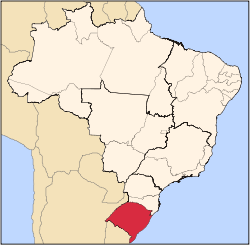City of Taquari | |
|---|---|
 ] ]Armenian Lagoon [Lagoa Armênia] | |
| Nicknames: Taquari, people's land | |
 Location in Rio Grande do Sul, Brazil | |
| Coordinates: 29°48′00″S51°51′35″W / 29.80000°S 51.85972°W | |
| Country | Brazil |
| Region | South |
| State | Rio Grande do Sul |
| Founded | 1849 |
| Government | |
| • Mayor | Emanuel Hassen de Jesus (PT) |
| Area | |
• Total | 349 km2 (135 sq mi) |
| Elevation | 54 m (177 ft) |
| Population (2022 [1] ) | |
• Total | 25,198 |
| Time zone | UTC−3 (BRT) |
| Website | Prefeitura de Taquary |
Taquari is a municipality in the state of Rio Grande do Sul, Brazil.



